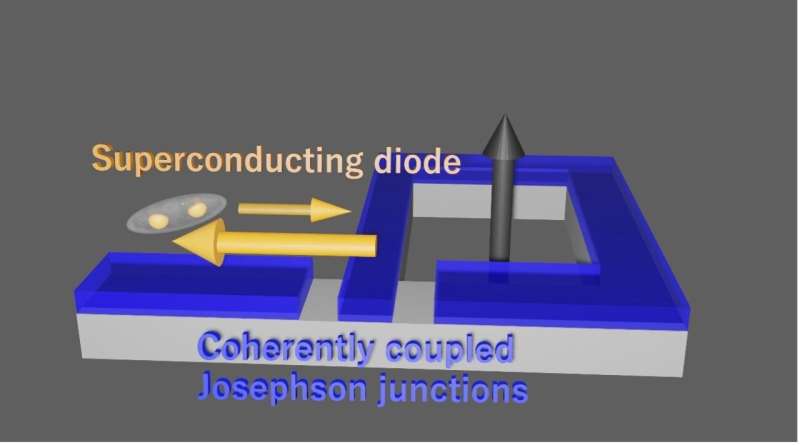August 23, 2023 feature
This article has been reviewed according to Science X's editorial process and policies. Editors have highlighted the following attributes while ensuring the content's credibility:
fact-checked
peer-reviewed publication
trusted source
proofread
The superconducting diode effect in a device based on coupled Josephson junctions

The so-called superconducting (SC) diode effect is an interesting nonreciprocal phenomenon, occurring when a material is SC in one direction and resistive in the other. This effect has been the focus of numerous physics studies, as its observation and reliable control in different materials could enable the future development of new integrated circuits.
Researchers at RIKEN and other institutes in Japan and the United States recently observed the SC diode effect in a newly developed device comprised of two coherently coupled Josephson junctions. Their paper, published in Nature Physics, could guide the engineering of promising technologies based on coupled Josephson junctions.
"We experimentally studied nonlocal Josephson effect, which is a characteristic SC transport in the coherently coupled Josephson junctions (JJs), inspired by a previous theoretical paper published in NanoLetters," Sadashige Matsuo, one of the researchers who carried out the study, told Phys.org.
"The recent study featured in Nature physics is an extension of our previous work about the nonlocal Josephson effect. Therefore, we utilized the same methods used in our previous paper."
The recent work by Matsuo and his colleague builds on their previous research efforts focusing on SC transport in coherently coupled JJs. To conduct their experiments, the team used a device that consists in two JJs sharing a single SC lead.
"When the shared SC lead is narrow, the two JJs are coherently coupled and interact with each other," Matsuo explained. "By embedding one JJ into the SC loop and measuring the other JJ, we can study the SC transport of the JJs affected by the other JJs through the coherent coupling."
By modulating the phase of the coupled JJs in their device, Matsuo and his colleagues were ultimately able to produce the SC diode effect. Their work thus unveiled a promising and reliable strategy to realize this effect in coupled JJs-based devices, while also shedding further light on the physics underpinning the effect in these devices.
"The SC diode effect itself is important because the phenomenon will be applied for dissipationless rectification in future SC circuits," Matsuo said. "Additionally, the SC diode effect emerges when SC devices do not have time-reversal and spatial-inversion symmetries. Therefore, our results suggest that the phase control of the coupled JJs can break such symmetries. This means that the other exotic SC phenomena expected with the symmetries broken may be realized in the coupled JJs."
In the future, this recent paper could open new opportunities for the field of electronics engineering. For instance, the methods they used could be applied to the development of new highly performing superconducting electronic components. Concurrently, the work by Matsuo and his colleagues could inspire other research teams worldwide to carry out similar studies using coupled JJs.
"We now plan to seek exotic SC phenomena other than the SC diode effect by controlling the coherent coupling of the JJs," Matsuo added.
More information: Sadashige Matsuo et al, Josephson diode effect derived from short-range coherent coupling, Nature Physics (2023). DOI: 10.1038/s41567-023-02144-x
Journal information: Nano Letters , Nature Physics
© 2023 Science X Network





















